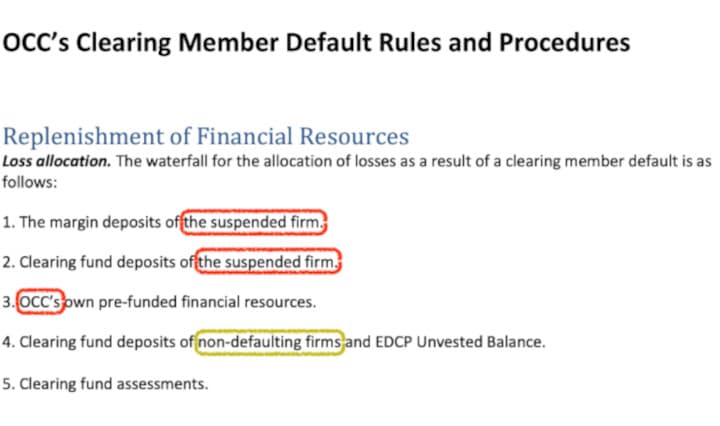Treasury Alert! Janet Yellen's remarks ring alarm🔔: Unmasking the Powder Keg of Money Markets & Hedge Funds 💣 - A Tangled Web of Risk, Leverage, and Regulatory Blind Spots. Dive in to learn more!

Remarks by Secretary of the Treasury Janet L. Yellen at the National Association for Business Economics 39th Annual Economic Policy Conference
Source: https://home.treasury.gov/news/press-releases/jy1376 (well worth a full read).
Before reviewing Yellen's remarks, some level setting:
- Macroprudential policy aims to bolster the resilience of the financial system against external shocks.
- Despite its focus on reducing systemic risks, recent government interventions in the financial sector reveal the inadequacy of these policies--liquidity is provided by inflation is not tamed.
- Fire sales, characterized by the forced liquidation of assets below their true value, can trigger a vicious cycle of plummeting prices and further sales, exposing common vulnerabilities and transmission channels that may spiral out of control.
- Regulators face a complex landscape involving banks, nonbank institutions, hedge funds, and digital assets--each posing unique risks and regulatory challenges.
Amidst these complexities, the question arises: Are our current policies and regulations sufficiently equipped to manage the risks within the financial system?
- Spoiler alert: absolutely not. No single regulator has the authority or information to comprehensively assess the risks posed by hedge funds.
Macroprudential policy:
- Is Macroprudential the new 'transitory'? (Bullard dropped the term today as well)
Macroprudential policy is not aimed at preventing external shocks nor eliminating all volatility in the financial system.
- Rather, macroprudential policy aims to make the financial system more resilient to external shocks – so the system can dampen, not amplify, their consequences for American households and businesses.
- But in both cases (SVB and Signature), the government has had to deliver substantial interventions to ease the pressure on certain parts of the financial system.
Fire sales:
- As described by Shleifer and Vishny, a fire sale is the forced sale of assets at a price below fundamental values.
- Building on this idea, Brunnermeier and Pedersen show how a negative shock to the net worth of collateralized borrowers can trigger a vicious cycle of forced asset sales.
- The resulting price declines trigger further forced sales. At each stage, the net worth of leveraged investors falls, requiring additional liquidations.
There are common vulnerabilities and transmission channels through which financial fires can get out of hand.
- Excessive leverage, especially when paired with maturity and liquidity mismatches, can increase the risk that fires spread out of control.
- Information asymmetries can also lead to runs that have the potential to accelerate and deepen asset fire sales.
Banks:
- Federal regulators are in the process of reviewing events surrounding the failure of SVB.
This month’s developments have been very different than those of the Global Financial Crisis--back then, many financial institutions came under stress due to their holdings of subprime assets.
- Yellen says they do not see that situation in the banking system today.
Nonbanks - Money Market and Open-End Funds:
- Many of these nonbank institutions engage in liquidity and maturity transformation: they profit by issuing short-term obligations while investing in riskier and longer-term assets.
- But they are generally not regulated to account for spillovers to the rest of the financial system during times of extreme stress.
- Similar activities that create comparable financial stability risks should be subject to comparable regulatory scrutiny.
- Policymakers should adapt and tailor policies to fit the unique structural features of the institutions and markets they are regulating.
If there is any place where the vulnerabilities of the system to runs and fire sales have been clear-cut, it is money market funds.
- These funds are widely used by retail and institutional investors for cash management; they provide a close substitute for bank deposits.
- Before the post-crisis reforms implemented by the SEC, all money market funds were generally expected to maintain a fixed $1 net asset value per share.
- The stable NAV was normally achievable because funds were generally limited to investments that were considered to be low risk.
- These funds were allowed to round their share prices to $1 when the market value of their investments fell – as long as it stayed above a certain level.
- But a fund had to respond if its market value fell below that level – that is, if it “broke the buck.” In that case, these funds would have to reprice, and they might cease withdrawals and liquidate their assets.
- This created an incentive for a run in times of extreme stress.
- The first redeemers could exit the fund at $1 per share, but those who waited might be subject to a reduced market value as they are left with claims on less-liquid assets.
This created a “first-mover advantage” – an incentive for investors to redeem at the whiff of a problem.
- During the Global Financial Crisis, anticipated losses on Lehman Brothers commercial paper led to a run on the $62 billion Reserve Primary Fund, the oldest money market fund in the nation.
- Concerns about Lehman then sparked concerns about commercial paper issued by other banks. This led to runs on other money market funds.
- A post-mortem report revealed that as many as 28 other funds had NAVs low enough for them to also break the buck.
Open-end funds offer daily redemptions, but some hold assets that cannot be sold quickly – particularly in large volumes.
- Like money market funds, this liquidity mismatch does not typically pose problems in normal times when flows to and from funds are not outsized.
- But in times of market stress, shareholders are incentivized to redeem early – before fire sales of illiquid assets lower the value of their holdings. Driven by this dynamic amid the pandemic shock, a record $255 billion flowed out of bond mutual funds in March 2020.
In the banking sector, capital and liquidity requirements and federal deposit insurance reduce the likelihood of runs taking place:
In case runs occur, access to the discount window helps provide buffers for banks.
Interestingly, today a Sunshine Meeting Notice for a CLOSED meeting under Expedited Procedures of the Board of Governors of the Federal Reserve System at 11:30 a.m. on April 10, 2023.
- Matter(s) considered: Review and determination of the advance and discount rates to be charged by the Fed.
- The financial stability risks posed by money market and open-end funds have not been sufficiently addressed.
Over the past two years, the SEC has proposed rules to mitigate the vulnerabilities plaguing these funds.
- The SEC’s proposals would reduce the first-mover advantage, reducing run incentives during times of stress.
- They would also require new liquidity management tools, while mandating more comprehensive and timely information on these funds for the SEC and investors.
Nonbanks - Hedge Funds:
- No single regulator has the authority or information to comprehensively assess the risks posed by hedge funds.
- The hedge fund industry has expanded significantly over the last five years.
- In 2021, gross assets reached almost $10 trillion, up more than 50 percent since 2016.
- Hedge funds are also playing a more prominent role in markets that lie at the core of the financial system – like the U.S. Treasury market.
Overall use of leverage among hedge funds is fairly small on average.
- Leverage appears to be concentrated among a select number of large hedge funds.
- Twenty-five funds account for around half of all hedge fund borrowing and derivatives exposures.
- Further, funds with certain strategies are engaged in very significant use of leverage.
- Leverage can support economic growth, but excessive leverage is dangerous.
- It can add fuel to fire sales by triggering a negative spiral of margin calls and rapid asset liquidations.
- These fire sales can transmit stress to hedge fund counterparties and other market participants – including large, systemic banks.
- Spillovers from these fire sales to other market participants remain a risk.
- In March 2020, these risks became reality--hedge funds were among the top three sellers of Treasury securities that month.
- FSOC has determined that they materially contributed to Treasury market dysfunction.
Treasury’s Office of Financial Research will continue to enhance data collection on bilateral repo transactions without a central counterparty.
- These are a key source of leverage for hedge funds.
Nonbanks - Digital Assets:
- Over the past decade, the digital assets ecosystem has grown significantly in scope and scale, in November 2021, global market capitalization reached approximately $3 trillion.
Treasury recommended that Congress enact legislation to establish a comprehensive prudential regulatory framework for stablecoin issuers.
- Such a framework would include consolidated federal supervision, requirements for how a coin could be backed, capital and liquidity requirements, and restrictions on affiliation with commercial companies.
- Treasury exploring broader policy issues around the future of money and payments – including the possibility of a central bank digital currency.
TLDRS:
If there is any place where the vulnerabilities of the system to runs and fire sales have been clear-cut, it is money market funds.
- Yet, the financial stability risks posed by money market and open-end funds have not been sufficiently addressed.
- No single regulator has the authority or information to comprehensively assess the risks posed by hedge funds.
Leverage can support economic growth, but excessive leverage is dangerous.
- It can add fuel to fire sales by triggering a negative spiral of margin calls and rapid asset liquidations.
- These fire sales can transmit stress to hedge fund counterparties and other market participants – including large, systemic banks.
- Spillovers from these fire sales to other market participants remain a risk.
In March 2020, these risks became reality--hedge funds were among the top three sellers of Treasury securities that month.
- FSOC has determined that they materially contributed to Treasury market dysfunction.
Treasury’s Office of Financial Research will continue to enhance data collection on bilateral repo transactions without a central counterparty.
- These are a key source of leverage for hedge funds.
Leverage appears to be concentrated among a select number of large hedge funds.
- Twenty-five funds account for around half of all hedge fund borrowing and derivatives exposures.
- Further, funds with certain strategies are engaged in very significant use of leverage.



